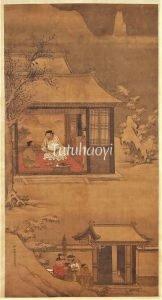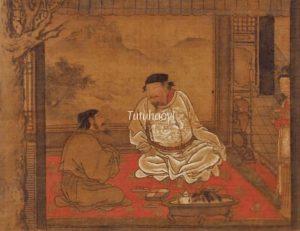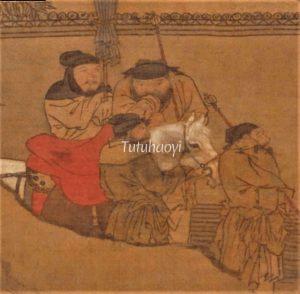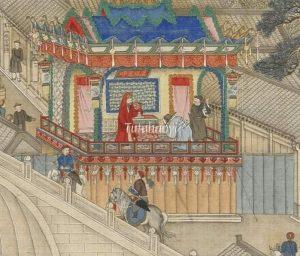Emperor Zhao Kuangyin Visiting Grand Chancellor Zhao Pu on a Snowing Evening
赵匡胤雪夜访赵普
© Tutuhaoyi.com owns the copyright of the description content for the images attached. Quoting all or part of the description content on this page is permitted ONLY IF ‘Tutuhaoyi.com’ is clearly acknowledged anywhere your quote is produced unless stated otherwise. (本页描述内容版权归Tutuhaoyi.com所有,转发或引用需注明 “Tutuhaoyi.com”, 侵权必究, 已注开源信息的条目除外。)
Evidently, Zhao Kuangyin (赵匡胤 927–976), Emperor Taizu of the Song dynasty (宋太祖), often paid unofficial surprise visits to his courtiers. As a result, his ministers did not dare to change their official attire into casual wear even when they returned home from court. They had to be ready for imperial visits any time and did not want to appear discourteous when the emperor arrived.
As Emperor Taizu’s most entrusted strategist, Zhao Pu (赵普 922–992) was the most important politician in the court of the first two Song emperors, Taizu and Taizong (宋太宗 939–997). Emperor Taizu often consulted him on matters of national security and power consolidation. ‘Emperor Zhao Kuangyin Visiting Grand Chancellor Zhao Pu on a Snowing Evening’ is an epitome of the emperor’s comradeship with his right-hand-man.
One bitterly cold snowy evening, Zhao looked at the blowing snow outside with a sense of relief. He thought that it would be most unlikely that the emperor would come out of his palace in such weather. No sooner had Zhao Pu sat down with a book than he was informed that the emperor was at the gate.
Zhao Pu hurried to the courtyard and knelt down to welcome the sovereign. Double mattresses were laid on the floor of the hall and barbecue grill racks were set to cook meat. When Zhao Pu’s wife came out to serve wine, the emperor addressed her as ‘Sister-in-law’.
During this casual home visit, the emperor told Zhao Pu his grave concern of reunifying China. Sure enough, Zhao Pu came up with effective strategies to subjugate various small kingdoms starting from the south, which was fertile and rich but weak in combat forces. The meeting laid the foundation of the following nineteen-year military campaigns that reunited the Chinese people.
image identification on porcelain and literature research by Dr Yibin Ni
Stories of emperors from other dynasties:
Night Revel of the Emperor Yang of the Sui Dynasty 隋炀帝夜游西苑
How a massacre in ancient China influenced European literature, painting and theatre
Fig 1-4: porcelain vase with underglaze blue and overglaze enamelled decoration, Shunzhi period (1644–61), courtesy of Porcelain Collection, Dresden State Art Museums
Fig 5-7: hanging scroll, ink and colour on silk, Liu Jun in early Ming dynasty (15th century), Palace Museum, Beijing
Fig 8: handscroll (detail), ink and colours on paper, Xu Yang (active 1750–77), courtesy of the National Museum of China







